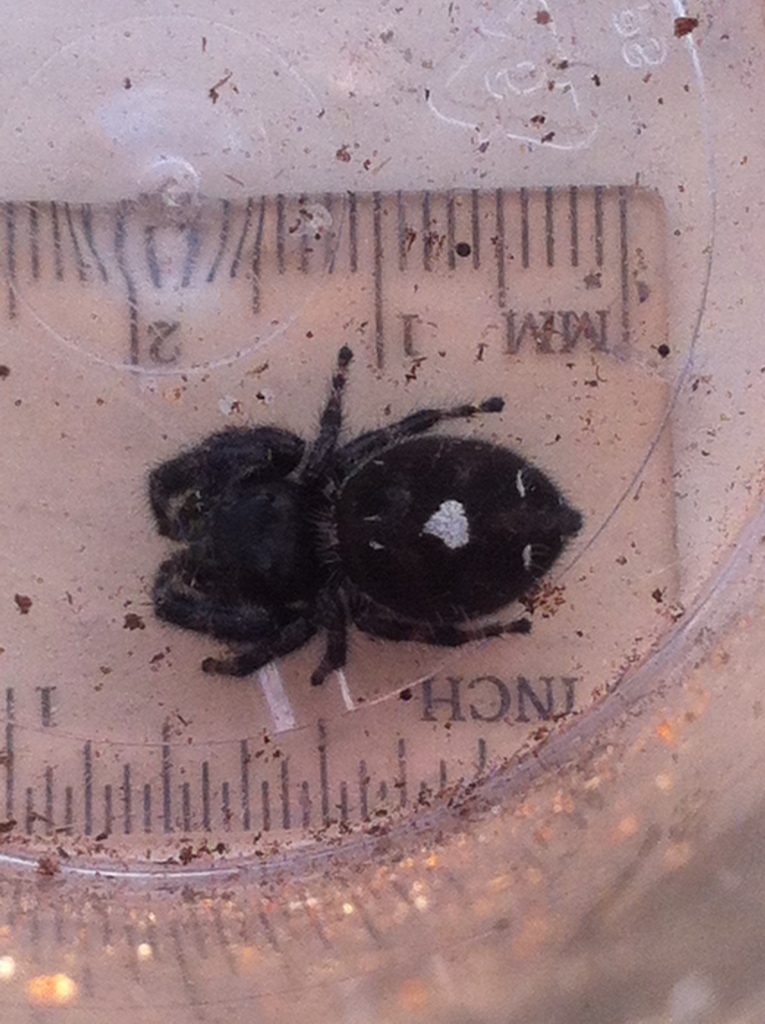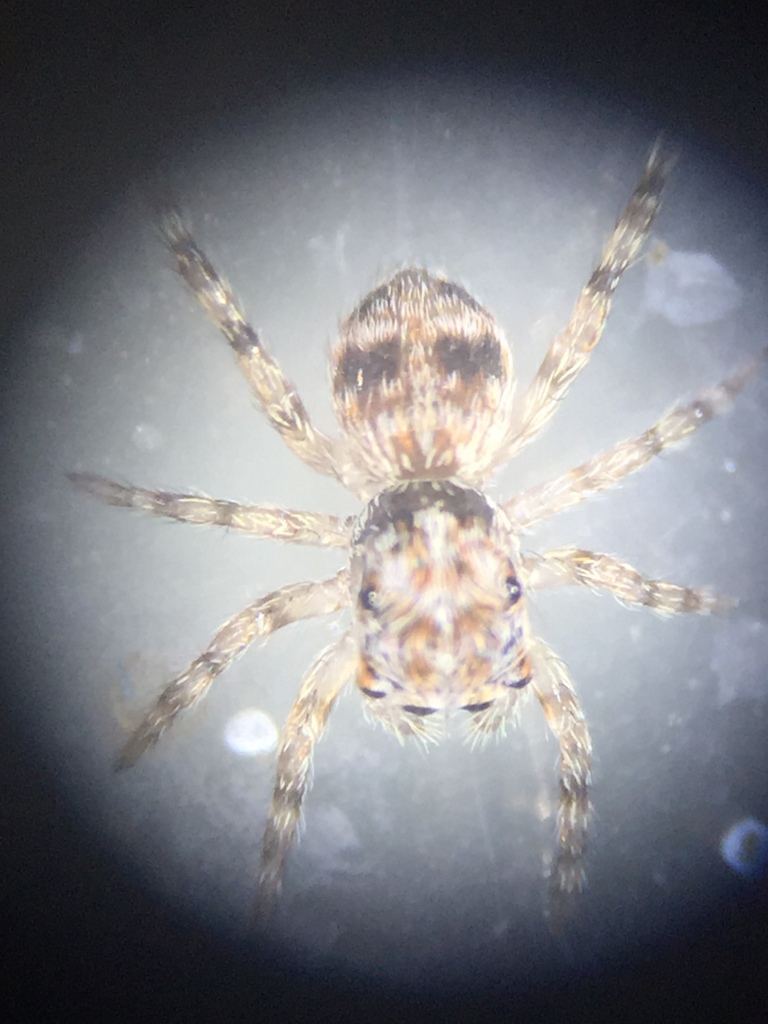I’ve been calling them “windowsill spiders” – small (~4mm), brown jumping spiders (Salticidae family) that appear against the white paint of the window sill as they scout for bugs. They were common enough, bland enough, and small enough that I never really gave them more thought than acknowledging that they were around.

Like most people, I tend to be more visually swayed by big, bright, or odd-looking spiders. Staying within the jumping spider family, I’m guessing anyone who has crossed paths with a full grown, female Bold Jumper will have a story to tell and may even be able to recite its scientific name, Phidippus audax. Phidippus audax females can have a body size of a half inch not counting the legs. They’re common, but not so common that they’re disregarded. You simply cannot disregard a bold jumper! See! It’s already stealing the show! Back to the little guys.

Realizing that I didn’t know anything about these frequently visiting little brown jumpers, I decided it was time to do some focusing. I caught two in November which confirmed that I was not seeing the same one over and over again. One was on the windowsill and the other was on the kitchen wall. The kitchen wall spider was a male and the other was undetermined. I caught a third male in March on a different windowsill.
These harmless, travelling spiders hunt during the day and hide in silken retreats at night. I was able to make some interesting observations having them in enclosures. There were many deserted retreats in the enclosures which meant they don’t return to the same “home”. Their retreats were lightly woven, translucent socks of silk that were just large enough for them to fit in. The retreats were made in the recesses of the bark that was attached to the side of the containers or in the skinny spaces between the bark and the containers.
I was able to identify these jumpers to species, Attulus fasciger. From a distance, they are mostly brown with two pale spots on the tops of their abdomens which was the only real stand out to me. Up close they have a lot of black/dark brown markings against tan. The two pale spots on the abdomen are a cream color and look like two commas facing each other. There is a light cream colored band that goes down the center of its rectangle-shaped head and the legs are banded.
The male and female look very much the same except the males have swollen, flattish, black palps which they wave around like tiny flags to visually stimulate the female. During my research, I learned that these spiders are truly vagabonds having been introduced into North America in the late 1950’s hailing from the eastern Palearctic region (Russia east of the Ural Mountains, Mongolia, China, Tibet, Korea and Japan). There is no record of this spider in a natural habitat. They’ve only been observed around human structures.

The undetermined jumper I caught in November molted into a mature female which was awesome! The next step would be to check out their courtship behavior, which can be quite entertaining! Jumping spiders are very visual. You can tell by how they follow movement, turning their whole bodies to face whatever they see. When there’s an object of allure in the sights of the males, they don’t hold back showing it! Read Jumping Spiders, the Rock Stars of the Araneae for more info on jumping spiders in general!
One of the males went missing. I was not surprised or alarmed by this – these spiders are good at escaping and I found him in the house anyway. I introduced the remaining male into the female’s enclosure and he immediately went into a dance. Over the course of many introductions (two days), the dance differed, but his approach was just as direct. At first, the female, just a tad bulkier than her male counterpart, stopped to observe, but did not return the excitement. Instead, she ran! And the male chased her! This fellow had no fear at all and continued to pursue and try to woo her waving his tiny palps like, “Hey! Hey! Over here! Lookit dis!” His persistence and boldness was completely different from the last courtship I wrote about in A Neospintharus Tale where the male seemed to be afraid of the female, and for good reason!
I couldn’t help but start naming the moves this jumper used. There was the tapdance, the sticky sway, the half moon robot, the roadblock, the trailer drag, the sidestep, the downright tackle, and an instance where he mistakenly danced for some dead fly carcasses that were all over the bottom of the container (I should’ve redd up before company). Eventually, the female gave in and the mating was successful. From what I observed, the male had to carefully face the female and then climb on top of her head. The palps of the male spider are where the sperm is stored for copulation so he had to get his palps into contact with the female epigynum which is on the female’s belly – an awkward position. Plus, he had to do it without her attacking him. It looked like once he was on her head, he would wiggle his abdomen and use his long back legs to distract her by tapping them against her and waving them around. There were actually a few successes, you know, just to make sure! I felt that the female would soon produce offspring and I would get to observe the whole glorious process and raise little windowsill jumpers! Here’s a video of all of the dances spliced together. See if you can spot the Sticky Sway…that was my favorite.
Two days after their successful mating, the female died. I don’t know why and uttered a long, “NOOOOOO!” when I discovered her. I kept the male for a few days thinking I would surely find another female travelling the windowsills, but none appeared. The little brown jumper had become a rare and valuable species. Funny how that works. I released the male back onto the windowsill with the window open so he could choose his next adventure.

There is a happy ending though. About a month later (July), as I was cleaning out the litter box, I caught sight of a tiny speck on the floor whose movement was very spider-like (jerky, quick, and in a straight line). Could it be?? I dropped everything to get a vial and when the speck reappeared, I caught it. Under the scope, I could see it was an Attulus fasciger spiderling! I was so excited! Even though it wasn’t one of “mine”, I was reassured that my house population was viable. Imagine how far generations of this spider had to travel to get into this country, this city, this house, and this very room!

I did not keep the spiderling. It has places to go and dances to perform (or flee from). All of this from a common, bland, small, brown spider on the windowsill. To quote Andy Warhol, “You need to let the little things that would ordinarily bore you suddenly thrill you.” Such is the way with the little brown jumper on the windowsill.

Cutler, BE (1990). Synanthropic Salticidae of the Northeast United States. Peckhamia 2: 91–92.
Maddison, W. P., Maddison, D. R., Derkarabetian, S. & Hedin, M. (2020). Sitticine jumping spiders: phylogeny, classification, and chromosomes (Araneae, Salticidae, Sitticini). ZooKeys 925: 1-54.
Matsumoto, S. and Y. Chikuni . 1987 . Notes on the life history of Sitticus fasciger (Simon, 1880) (Araneida, Salticidae). J. Arachnol., 15 :205-212.
Prószyński, J. (2017a). Revision of the genus Sitticus Simon, 1901 s. l. (Araneae: Salticidae). Ecologica Montenegrina 10: 35-50.


Wonderful tale. These are indeed very common around buildings throughout Ohio where I live. I love the Warhol quote!
LikeLike
Thank you, Rich!
LikeLike
Got my own of this kind here in Russia, it seems. Small jumping spider has been living on my windowsill for a couple of months. There are not many insects in the room, I even think there are none at times, so I started to wonder: what does the spider eat and how does he manage to survive on mosly air and not much else. Never seen it hunting either. Maybe I should figure out a way to help the little fella somehow. Thanks for an elucidating story!
LikeLike
You’re welcome, Ed! That’s so cool that you have a windowsill spider, too! I wonder if the reason there are no insects in the room is because the spider is there?
LikeLike
I doubt it. There are few insects inside because we live nearby the forest and a river. All the windows have nets on them, otherwise the rooms will be packed with gnats in no time. Some gnats get in anyway sometimes , of course, and it’s usually me who’s forced to hunt them. If the spider did it for me I’d be much obliged.
LikeLike